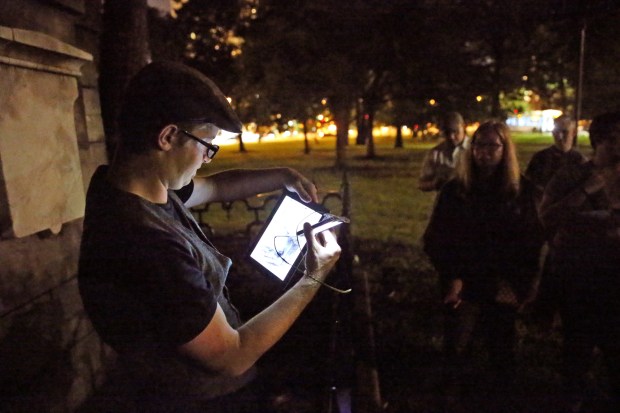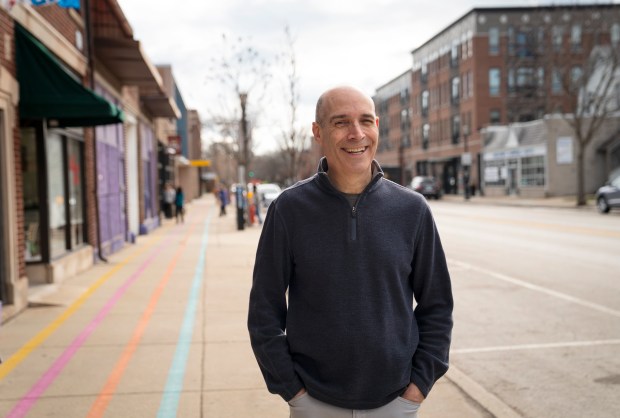Having recently written about a book titled “The 500 Hidden Secrets of Chicago,” and having more recently watched an upcoming television show called “Chicago Mysteries,” have I finally, at long last, become all-knowing?
Certainly not, but I know plenty and some of that is due to the book, written by a former Tribune colleague named Lauren Viera, about which I wrote, “Many places on these pages … will surprise you only if you have been living under a rock for the last decade. But Viera does a thoughtful job of enlivening even the most familiar.”
The same is true with “Chicago Mysteries,” which premieres at 7 p.m. April 16 on WTTW-Ch. 11. One of the reasons is that Geoffrey Baer’s frequent jaunts — on the river, to “beautiful places,” back into the city’s history — are handsomely produced, edited, filmed and jam-packed.
I am a fan of secrets but also know that I, we all, live in a world where most “secrets” are as close as your phone or computer keyboard. Do we really need to buy and read books or watch television shows that claim to offer answers to questions we’ve never asked? When you get to know secrets and solve mysteries, does that not take some of the fun out of life?
That said, what’s the harm in having Baer take us back to the sky above O’Hare International Airport where, in 2006, people claimed to have seen a “flying disc”?
“Was it a UFO?” is the question that compels Baer to interview my former colleague, John Hilkevitch, who wrote in this newspaper in 2007 that “Covering UFOs seemed to be stretching the definition of my job, transportation reporting … The UFO story … became the most-read piece to appear on chicagotribune.com … garnering more than 1 million page views from people around the world.”
Hilkevitch has his say in the TV show and so does recently retired WGN meteorologist Tom Skilling, who pops up to give us a scientific explanation and, as you surely have assumed, it was not a UFO but rather something called a “hole punch cloud.”
The program then hooks up with the lively and smart historian/author/tour guide Adam Selzer, who takes Baer to the Couch Mausoleum, which sits in Lincoln Park near the Chicago History Museum and is the final resting place of a businessman named Ira Couch, who lived from 1806-1857. It is the tomb that some pint-sized pals and I tried to break into with some regularity but to no avail in the 1960s, using hammers and screwdrivers and whatever else we could find. We never got in and neither do Baer and Selzer, who wisely proceeded to Graceland Cemetery, a repository of beauty and intriguing mysteries and substantial history.

I surely would have done without a segment that revisits that relatively recent local celebrity, Chance the Snapper, but it was nice to learn he’s doing OK in Florida.
It was nice to see another former colleague, Monica Eng, who now works at Axios, provide Baer with a playful few minutes on the “relationship” between hot dogs and ketchup. TikTok star and tour guide Shermann “Dilla” Thomas does a good job of explaining the “mystery” behind that local breed of building known as a “garlow.” And Jessica Mlinaric, author of 2018’s “Secret Chicago: A Guide to the Weird, Wonderful, and Obscure” (Reedy Press), takes us to the Far South Side to see where the first nuclear reactor is buried.
Baer and his producers have a sharp ability to find compelling on-camera guests and you’ll see such in gallery owner John Corbett and publisher Julia Klein as they discuss a fascinating old mob book from the 1930s, and Indigenous educator Starla Thompson on the meaning of a twisted tree in the suburbs.
Of special note are Marianne Mather and Kori Rumore Finley, colleagues and friends, both passionate about photography and history. They give us a look at something called the Foolkiller, a 30-foot long and 20-foot wide canvas-covered vessel, sort of a floating blimp, that was made to glide across land or water, and the man who created it, Peter Nissen, a local bookkeeper and daredevil who died trying to cross Lake Michigan in 1904. Yet another colleague, editor/author Robert Loerzel, takes us to the site of his wonderfully spooky book, “Alchemy of Bones.” (He is also the author of the fine “Walking Chicago: 35 Tours of the Windy City’s Dynamic Neighborhoods and Famous Lakeshore.”)
There is a lot packed into this handsomely edited and filmed hour and there is a companion website that offers such extras as Baer’s production diary, and a few more “mysteries,” such as a Salvador Dalí painting at the Art Institute, a slab of concrete in a library at the University of Chicago Library, and why the 1982 Tylenol murders remain unsolved.
Baer is ever the enthusiastic, curious host. He says that he “hopes people will come away from this show thinking, ‘I never knew that,’ and maybe even feel inspired to explore more corners of our city and suburbs on their own.”
Indeed, indeed. Get up, get out.
rkogan@chicagotribune.com



